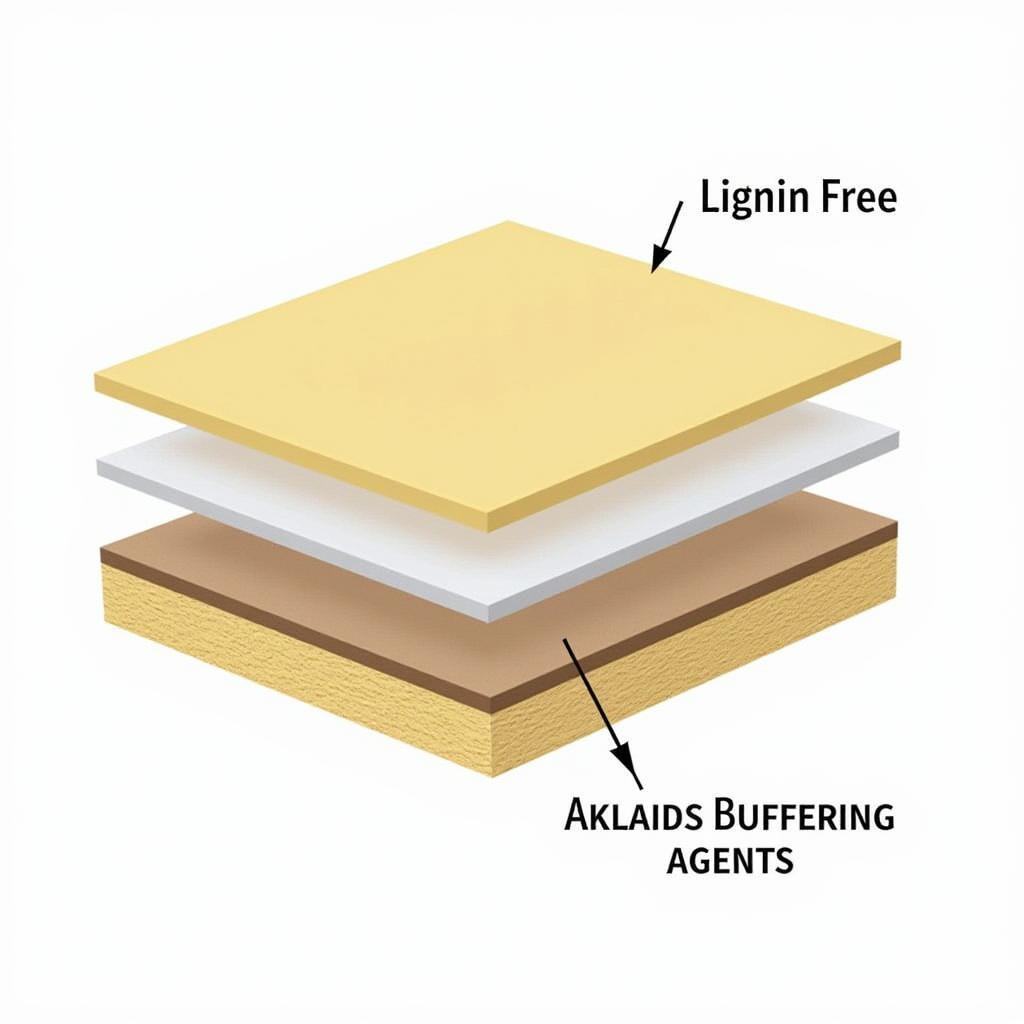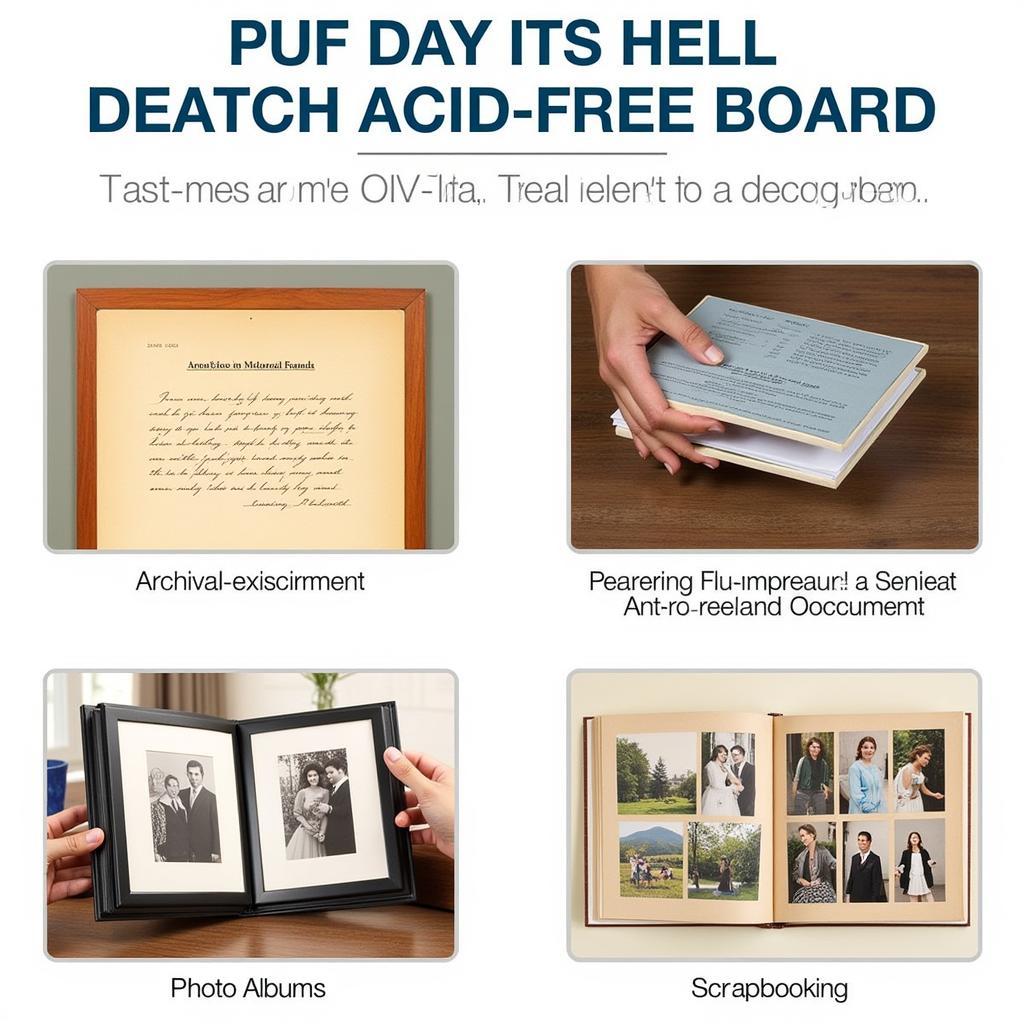Acid-free board is a type of paper or board that is specifically manufactured to be free of acids and other chemicals that can cause deterioration over time. This makes it ideal for preserving and protecting valuable documents, artwork, and photographs. But what exactly constitutes an acid-free board, and why is it so crucial for long-term preservation?
What Makes a Board Acid-Free?
Paper is primarily made from wood pulp, which naturally contains lignin. Lignin is an acidic substance that, over time, can cause paper to become yellow, brittle, and eventually disintegrate. To combat this, acid-free boards are treated to neutralize these acids and prevent their formation in the future.
 Structure of Acid-Free Board
Structure of Acid-Free Board
Here are key characteristics of acid-free board:
- Neutral pH: A pH level of 7 is considered neutral. Acid-free boards have a pH of 7 or slightly higher, ensuring they won’t contribute to the breakdown of materials stored within them.
- Buffered: Many acid-free boards are also buffered, meaning they contain an alkaline substance (like calcium carbonate) that neutralizes any acids that might come into contact with them. This provides an extra layer of protection against environmental factors.
- Lignin-Free (Ideally): The best acid-free boards are made from materials that are naturally lignin-free, such as cotton or linen rag. However, high-quality wood pulp boards can also be treated to remove lignin effectively.
Why Choose Acid-Free Board?
The primary reason to choose acid-free board is for preservation. Whether you’re storing important documents, cherished photographs, or valuable artwork, acid-free materials provide the best defense against the ravages of time.
- Prevents Yellowing and Brittleness: Acid is a primary culprit in the yellowing and brittleness of paper over time. Acid-free board halts this process, keeping your items looking their best.
- Protects Against Environmental Damage: Pollutants in the air, humidity, and light exposure can all contribute to the degradation of paper-based items. Acid-free boards act as a barrier, mitigating the effects of these external factors.
- Ensures Long-Term Value: By preserving the condition of your valuable items, you are also protecting their historical, sentimental, and monetary value for generations to come.
Common Uses of Acid-Free Board
The applications of acid-free board are vast, ranging from personal use to professional archival purposes. Here are some common examples:
- Archival Storage: Museums, libraries, and archives rely heavily on acid-free archive boxes to safeguard historical documents, maps, and photographs for future generations.
- Artwork Preservation: Artists and collectors utilize acid-free boards for mounting, framing, and storing artwork to prevent deterioration and maintain its value.
- Photography Storage: Photographers and enthusiasts trust acid-free materials to protect precious memories from fading, yellowing, and damage.
- Scrapbooking: Acid-free paper and boards are essential for scrapbooking, ensuring that cherished memories and mementos are preserved for years to come.
 Various Applications of Acid-Free Board
Various Applications of Acid-Free Board
What to Look For When Choosing Acid-Free Board
Not all boards labeled “acid-free” are created equal. Here are key factors to consider:
- PAT Passed: Look for boards that are labeled as “PAT Passed” (Photographic Activity Test). This certification indicates that the board has passed rigorous testing to ensure its archival quality.
- Board Thickness: The thickness of the board, measured in points, will determine its rigidity and suitability for different applications. Thicker boards provide more support for heavier items.
- Surface Texture: Acid-free boards come in various surface textures, from smooth to textured. Consider the specific needs of your project when choosing a texture.
Acid-Free vs. Acid-Neutral: Understanding the Difference
While often used interchangeably, there is a subtle difference between “acid-free” and “acid-neutral” materials.
- Acid-Free: As discussed, refers to materials specifically manufactured without acid.
- Acid-Neutral: Indicates that the material’s pH has been neutralized but might not be entirely acid-free. This is often achieved through chemical treatments.
For true archival purposes, opting for materials explicitly labeled “acid-free” and “PAT Passed” is always the safest bet.
Protecting Your Precious Items: Making the Investment
Investing in acid-free boards is an investment in the preservation of your valued possessions. While they might cost slightly more than standard boards, the long-term benefits far outweigh the initial expense. By choosing acid-free materials, you are actively safeguarding your treasures from the damaging effects of time and ensuring their longevity for generations to come.
FAQ: Acid-Free Board
1. Can I make my own acid-free board?
While you can find DIY methods online, achieving true archival quality at home is difficult. It’s always recommended to purchase certified acid-free boards from reputable suppliers.
2. How long do acid-free materials last?
With proper storage conditions (cool, dry, dark), acid-free boards can last for centuries, significantly prolonging the life of the items they protect.
3. Are acid-free boards recyclable?
Yes, most acid-free boards are recyclable. However, always check with your local recycling guidelines to be sure.
4. What other materials should I use with acid-free boards?
When preserving valuable items, use acid-free tapes, adhesives, and writing instruments to avoid introducing acids that could compromise your efforts.
5. Where can I buy acid-free boards?
Acid-free boards are readily available at art supply stores, framing shops, online retailers, and specialized archival supply companies.
Need Help with Preservation?
Protecting your valuable items can be daunting. If you have questions or need assistance with archival-quality storage solutions, our team is here to help! Contact us at 0972669017, email us at [email protected], or visit us at 142 Tran Nhan Tong, Yen Thanh, Uong Bi, Quang Ninh, Vietnam. We offer 24/7 customer support and are always happy to assist you.
You might also be interested in these articles:
- Mattresses with free adjustable base: Discover the comfort and benefits of an adjustable base included with your new mattress purchase.
- Wedding dress boxes for storage acid free: Preserve your precious wedding gown for years to come with our guide to acid-free storage solutions.
- Pork free charcuterie: Explore delicious and creative charcuterie board options that are entirely pork-free.
- Needle free serum: Learn about the latest advancements in skincare with needle-free serum delivery systems.